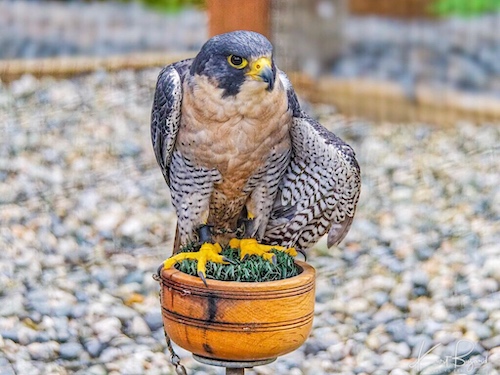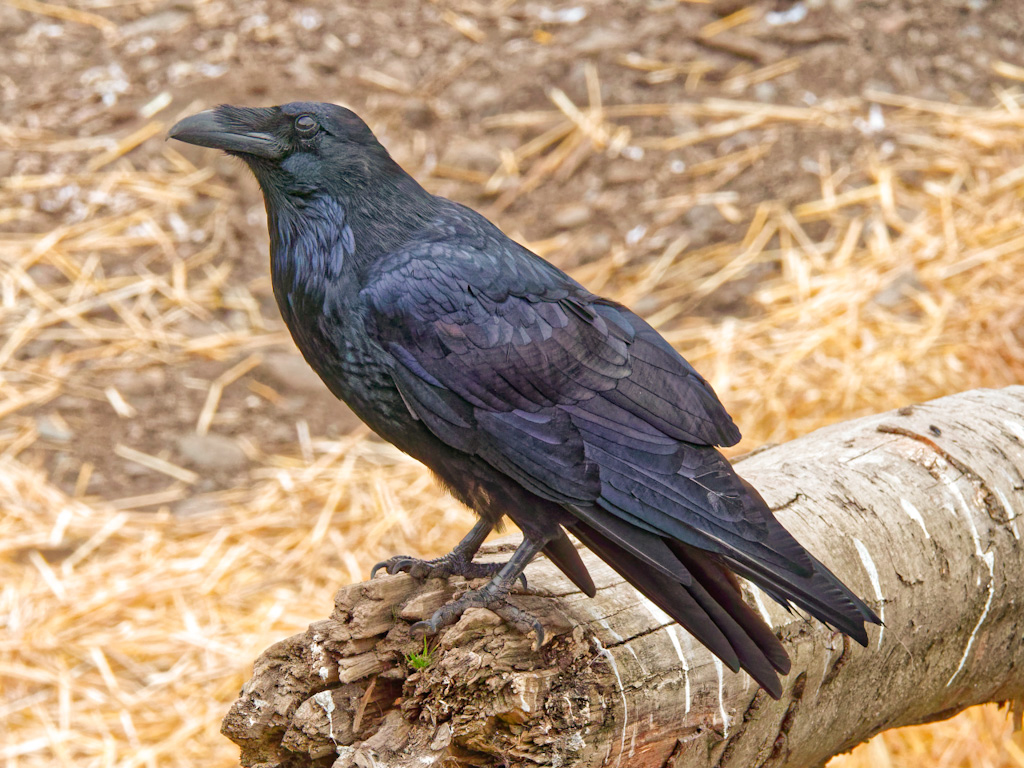
Within walking distance from downtown Sitka (just 20 minutes from Centennial Hall), a visit to the Raptor Center is the perfect way to stretch your legs and see Alaska’s wild birds up close. Learn about the different species, see their rehabilitation in action, and enjoy a stroll along the grounds. The Alaska Raptor Center’s number one goal is to rehabilitate, then send birds back to the wild. The Center treats between 100–200 birds each year and provides a permanent home for 25 “Raptors-in-Residence,” who can no longer fly or fend for themselves. Look eagles in the eye, gape at the head rotation of a snowy owl, and check out a variety of other species such as American kestrel, peregrine falcon, great-horned owl, Swainson’s hawk, and even the tiny pygmy owl. The raptor seen above is nicknamed “Pele” the Peregrine Falcon. He is both beautiful and typical of the 25 or so permanent residents due to a wing injury.
Peregrine Falcon


The peregrine falcon (Falco peregrinus), also known as the peregrine, and historically known as the duck hawk in North America, is a widespread bird of prey (raptor) in the family Falconidae. A large, crow-sized falcon, it has a blue-grey back, barred white underparts, and a black head. As is typical of bird-eating raptors, peregrine falcons are sexually dimorphic, with females being considerably larger than males. The peregrine is renowned for its speed, reaching over 320 km/h (200 mph) during its characteristic hunting stoop (high-speed dive), making it the fastest member of the animal kingdom. According to a National Geographic TV program, the highest measured speed of a peregrine falcon is 389 km/h (242 mph). Falconry is the hunting of wild animals in their natural state and habitat by means of a trained bird of prey. There are two traditional terms used to describe a person involved in falconry: a falconer flies a falcon; an austringer (German origin) flies a hawk (Accipiter and some buteos and similar) or an eagle (Aquila or similar). In modern falconry, the red-tailed hawk (Buteo jamaicensis), the Harris’s hawk (Parabuteo unicinctus), and the peregrine falcon (Falco perigrinus) are some of the more commonly used birds of prey. Falconry is currently practiced in many countries around the world. The falconer’s traditional choice of bird is the northern goshawk and peregrine falcon. Between 1972 and 2001, nearly all peregrines used for falconry in the U.S. were captive-bred from the progeny of falcons taken before the U. S. Endangered Species Act was enacted and from those few infusions of wild genes available from Canada and special circumstances. Peregrine falcons were removed from the United States’ endangered species list on August 25, 1999. The Peregrine is often described as the “King” of falconry due to it’s prominence as the falcon of Kings.
Golden Eagle


The golden eagle (Aquila chrysaetos) is one of the best-known birds of prey in the Northern Hemisphere. It is the most widely distributed species of eagle. Like all eagles, it belongs to the family Accipitridae. These birds are dark brown, with lighter golden-brown plumage on their napes. Immature eagles of this species typically have white on the tail and often have white markings on the wings. Golden eagles use their agility and speed combined with powerful feet and massive, sharp talons to snatch up a variety of prey, mainly hares, rabbits, marmots and other ground squirrels. This one has the nickname “Oliver”.
Bald Eagle



The bald eagle (Haliaeetus leucocephalus) is a bird of prey found in North America. A sea eagle, it has two known subspecies and forms a species pair with the white-tailed eagle (Haliaeetus albicilla). It is found near large bodies of open water with an abundant food supply and old-growth trees for nesting. The bald eagle’s natural range covers most of North America, including most of Canada, all of the continental United States, and northern Mexico. It is the only sea eagle endemic to North America. Occupying varied habitats from the bayous of Louisiana to the Sonoran Desert and the eastern deciduous forests of Quebec and New England, northern birds are migratory, while southern birds are resident, remaining on their breeding territory all year. At minimum population, in the 1950s, it was largely restricted to Alaska, the Aleutian Islands, northern and eastern Canada, and Florida. Today, they are much more common, and nest in every continental state and province in the United States and Canada. The majority of bald eagles in Canada are found along the British Columbia coast while large populations are found in the forests of Alberta, Saskatchewan, Manitoba and Ontario. Bald eagles also congregate in certain locations in winter.

The bald eagle is an opportunistic feeder which subsists mainly on fish, which it swoops down and snatches from the water with its talons. It builds the largest nest of any North American bird and the largest tree nests ever recorded for any animal species, up to 4 m (13 ft) deep, 2.5 m (8.2 ft) wide, and 1 metric ton (1.1 short tons) in weight.
Red-Tailed Hawk


The red-tailed hawk (Buteo jamaicensis) is a bird of prey that breeds throughout most of North America, from the interior of Alaska and northern Canada to as far south as Panama and the West Indies. It is one of the most common members within the genus of Buteo in North America or worldwide.[2] The red-tailed hawk is one of three species colloquially known in the United States as the “chickenhawk,” though it rarely preys on standard-sized chickens. The subspecies Harlan’s hawk (B. j. harlani) is sometimes considered a separate species (B. harlani). The red-tailed hawk is one of the largest members of the genus Buteo. This identification is guided by several factors, the immature bald eagle has a silver eye and a yellow beak. Additionally, I know they have a Red Tailed Harlan’s hawk in the collection, I could be wrong, but I think this identification is correct.
Barred Owl




The barred owl (Strix varia), also known as northern barred owl or hoot owl, is a true owl native to eastern North America. Adults are large, and are brown to grey with barring on the chest. Barred owls have expanded their range to the west coast of the United States and Canada, where they are considered invasive. Mature forests are their preferred habitat, but they are also found in open woodland areas. Their diet consists mainly of small mammals, but they are also known to prey upon other small animals such as birds, reptiles, and amphibians. Barred owls are partly responsible for the recent decline of the northern spotted owl, native to British Columbia, Washington, Oregon, and California. The 2011 Revised Recovery Plan for the Northern Spotted Owl states “Based on the best available scientific information, competition from the barred owl (S. varia) poses a significant and complex threat to the spotted owl.” Since the 1960s, barred owls have been expanding their range westward from the eastern US and Canada. When spotted owls and barred owls share the same area, the barred owls generally are more aggressive and out-compete the spotted owls, leading to decreased populations of the native owls.
Great Grey Owl

The great grey owl or great gray owl (Strix nebulosa) is a very large owl, documented as the world’s largest species of owl by length. It is distributed across the Northern Hemisphere, and it is the only species in the genus Strix found in both Eastern and Western Hemispheres. In some areas it is also called Phantom of the North, cinereous owl, spectral owl, Lapland owl, spruce owl, bearded owl, and sooty owl. In terms of length, the great grey owl is believed to exceed the Eurasian eagle-owl and the Blakiston’s fish owl as the world’s largest owl. The great grey is outweighed by those two species as well as several others, including most of the genus Bubo. Much of its size is deceptive, since this species’ fluffy feathers, large head and the longest tail of any extant owl obscure a body lighter than that of most other large owls.
American Kestrel




The American kestrel (Falco sparverius) is the smallest and most common falcon in North America. It has a roughly two-to-one range in size over subspecies and sex, varying in size from about the weight of a blue jay to a mourning dove. It also ranges to South America, and is a well-established species that has evolved seventeen subspecies adapted to different environments and habitats throughout the Americas. It exhibits sexual dimorphism in size (females being moderately larger) and plumage, although both sexes have a rufous back with noticeable barring. Its plumage is colorful and attractive, and juveniles are similar in plumage to adults. As you can tell, this is one of my favorites, nicknamed “Sophie”. As you can see from the above figure, Sophie is a female.
Common Raven

The common raven (Corvus corax) is a member of a family of birds known as the Corvidae, which includes jays, crows, and magpies. In Alaska, the raven can only be confused with a hawk or the much smaller crow. Ravens have large, stout bills, shaggy throat feathers, and wedge-shaped tails, visible best when in flight. Common ravens are large passerine (or perching) birds that average 25 inches (63 centimeters) in length and 2.6 pounds (1.2 kilograms) in weight. They are not really raptors but since they are all around, i thought I would include a picture.
References:
https://www.audubon.org/news/being-good-american-kestrel-dad-comes-cost
